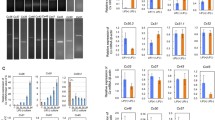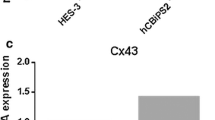Abstract
Programmed cell death (apoptosis) occurs both during normal development and as a result of various pathological conditions. An in vitro system was used to explore the transmission of death signals from apoptotic cells to cells with which they were coupled via gap junctions. Confluent cultures of baby hamster kidney (BHK) cells, stably transfected with the gap-junctional protein connexin32, were scrape loaded with cytochrome C (cyC), a mitochondria-derived apoptotic agent, to introduce the protein into cells injured by the cut. The cultures were subsequently analyzed for the presence of activated caspases, the distribution of TUNEL staining, and the binding of annexin V. Although cyC is too large to traverse the gap junctional channel, each of the assays revealed that apoptosis had spread from dying cells at the margin of the scrape to otherwise healthy neighboring cells to which they were coupled. This ‘bystander effect’ was significantly reduced in the presence of agents that block gap junctional intercellular communication.
Similar content being viewed by others
References
Willecke K, Eiberger J, Degen J, et al. Structural and functional diversity of connexin genes in the mouse and human genome. Biol Chem 2002; 383: 725–737.
Freeman SM, Abboud CN, Whartenby KA, et al. The “bystander effect”: Tumor regression when a fraction of the tumor mass is genetically modified. Cancer Res 1993; 53: 5274–5283.
Mesnil M, Piccoli C, Tiraby G, Willecke K, Yamasaki H. Bystander killing of cancer cells by herpes simplex virus thymidine kinase gene is mediated by connexins. Proc Nat Acad Sci USA 1996; 93: 1831–1835.
Mesnil M and Yamasaki H. Bystander effect in herpes simplex virus-thymidine kinase/ganciclovir cancer gene therapy: Role of gap-junctional intercellular communication. Cancer Res 2000; 60: 3989–3999.
Lin JH, Weigel H, Cotrina ML, et al. Gap-junction-mediated propagation and amplification of cell injury. Nat Neurosci 1998; 1: 494–500.
Linden R. The anti-death league: Associative control of apoptosis in developing retinal tissue. Brain Res Brain Res Rev 2000; 32: 146–158.
Cusato K, Bosco A, Rozental R, et al. Gap junctions mediate bystander cell death in developing retina. J Neurosci 2003; 23: 6413–6422.
Kumar NM, Friend DS, Gilula NB. Synthesis and assembly of human β1 gap junctions in BHK cells by DNA transfection with the human β1 cDNA. J Cell Sci. 1995; 108: 3725–3734.
El-Fouly MH, Trosko JE, Chang CC. Scrape loading and dye transfer. A rapid and simple technique to study gap junctional intercellular communication. Exp Cell Res 1987; 168: 422–430.
McKarns SC, Doolittle DJ. Limitations of the scrape-loading/dye transfer technique to quantify inhibition of gap junctional intercellular communication. Cell Biol Toxicol 1992; 8: 89–103.
Opsahl H, Rivedal E. Quantitative determination of gap junction intercellular communication by scrape loading and image analysis. Cell Adhesion Commun 2000; 7: 367–375.
Loch-Caruso R, Caldwell V, Cimini M, Juberg D. Comparison of assays for gap junctional communication using human embryocarcinoma cells exposed to dieldrin. Fundam Appl Toxicol 1990; 15: 63–74.
Goodenough DA, Goliger JA, Paul DL. Connexins, connexons, and intercellular communication. Annu Rev Biochem 1996; 65: 475–502.
Sgonc R, Boeck G, Dietrich H, Gruber J, Recheis H, Wick G. Simultaneous determination of cell surface antigens and apoptosis. Trends Genet 1994; 10: 41–42.
Goldstein JC, Waterhouse NJ, Juin P, Evan GI, Green DR. The coordinate release of cytochrome c during apoptosis is rapid, complete and kinetically invariant. Nature Cell Biol 2000; 2: 156–162.
Koopman G, Reutelingsperger CP, Kuijten GA, Keehnen RM, Pals ST, van Oers MH. Annexin V for flow cytometric detection of phosphatidylserine expression on B cells undergoing apoptosis. Blood 1994; 84: 1415–1420.
Boersma AW, Nooter K, Oostrum RG, Stoter G. Quantification of apoptotic cells with fluorescein isothiocyanate-labeled annexin V in chinese hamster ovary cell cultures treated with cisplatin. Cytometry 1996; 24: 123–130.
Earnshaw WC, Martins LM, Kaufmann SH. Mammalian caspases: Structure, activation, substrates, and functions during apoptosis. Annu Rev Biochem 1999; 68: 383–424.
Tanaka T, Yamasaki H, Mesnil M. Stimulation of intercellular communication of poor-communicating cells by gap-junction-competent cells enhances the HSV-TK/GCV bystander effect in vitro. Int J Cancer 2001; 91: 538–542.
Cusato K, Zakevicius J, Ripps H. An experimental approach to the study of gap-junction-mediated cell death. Biol Bull. 2003; 205: 197–199.
Wang X. The expanding role of mitochondria in apoptosis. Genes Dev 2001; 15: 2922–2933.
Kluck RM, Bossy-Wetzel E, Green DR, Newmeyer DD. The release of cytochrome c from mitochondria: A primary site for Bcl-2 regulation of apoptosis. Science 1997; 275: 1132–1136.
Li F, Srinivasan A, Wang Y, Armstrong RC, Tomaselli KJ, Fritz LC. Cell-specific induction of apoptosis by microinjection of cytochrome c. J Biol Chem 1997; 272: 30299–30305.
Zhivotovsky B, Orrenius S, Brustugun OT, Doskeland SO. Injected cytochrome c induces apoptosis. Nature 1998; 391: 449–450.
Deshmukh M, Johnson EM Jr. Evidence of a novel event during neuronal death: Development of competence-to-die in response to cytoplasmic cytochrome c. Neuron 1998; 21: 695–705.
Bhuyan AK, Varshney A, Mathew MK. Resting membrane potential as a marker of apoptosis: Studies on Xenopus oocytes microinjected with cytochrome c. Cell Death Differ 2001; 8: 63–69.
Li P, Nijhawan D, Budihardjo I, et al. Cytochrome c and dATP-dependent formation of Apaf-1/caspase-9 complex initiates an apoptotic protease cascade. Cell 1997; 91: 479–489.
Jiang X, Wang X. Cytochrome c promotes caspase-9 activation by inducing nucleotide binding to Apaf-1. J Biol Chem 2000; 275: 31199–31203.
Acehan D, Jiang X, Morgan DG, Heuser JE, Wang X, Akey CW. Three dimensional structure of the apoptosome: Implication for assembly, procaspase-9 binding, and activation. Mol Cell 2002; 9: 423–432.
Thorburn A. Death receptor-induced cell killing. Cellular Signalling 2004; 16: 139–144.
Thornberry NA, Lazebnik Y. Caspases: Enemies within. Science 1998; 281: 1312–1316.
Kaufmann SH, Hengartner MO. Programmed cell death: Alive and well in the new millenium. Trends Cell Bio 2001; 11: 526–534.
Ferri KF, Kroemer G. Organelle-specific initiation of cell death pathways. Nat Cell Biol 2001; 3: E255–E263.
Berson EL. Retinitis pigmentosa. The Friedenwald Lecture. Invest Ophthalmol Vis Sci 1993; 34: 1659–1676.
Travis GH. 1998. Human genetics ′98: Apoptosis. Mechanisms of cell death in the inherited retinal degenerations. Am J Hum Genet 1998; 62: 503–508.
Ripps H. Cell death in retinitis pigmentosa: Gap junctions and the ‘bystander effect’. Exp Eye Res 2002; 74: 327–336.
Raviola E, Gilula NB. Gap junctions between photoreceptor cells in the vertebrate retina. Proc Nat Acad Sci USA 1973; 70: 1677–1681.
Smith RG, Freed MA, Sterling P. Microcircuitry of the dark-adapted cat retina: Functional architecture of the rod-cone network. J Neurosci 1986; 6: 3505–3517.
Deans MR, Volgyi B, Goodenough DA, Bloomfield SA, Paul DL. Connexin36 is essential for transmission of rod-mediated visual signals in the mammalian retina. Neuron 2002; 36: 703–712.
Krutovskikh VA, Piccoli C, Yamasaki H. Gap junction intercellular communication propagates cell death in cancerous cells. Oncogene 2002; 21: 1989–1999.
Charles AC, Naus CC, Zhu D, Kidder GM, Dirksen ER, Sanderson MJ. Intercellular calcium signaling via gap junctions in glioma cells. J Cell Biol 1992; 188: 195–201.
Jayaraman T, Marks AR. T cells deficient in inositol 1,4,5-trisphosphate receptor are resistant to apoptosis. Mol Cell Biol 1997; 17: 3005–3012.
McConkey DJ, Orrenius S. Signal transduction pathways in apoptosis. Stem Cells 1996; 14: 619–631.
Sakakura C, Hagiwara A, Fukuda K, et al. Possible involvement of inositol 1,4,5-trisphosphate receptor type 3 (IP3R3) in the peritoneal dissemination of gastric cancers. Anticancer Res 2003; 23: 3691–3697.
Fukuzawa K, Kogure K, Morita M, Hama S, Manabe S, Tokumura A. Enhancement of nitric oxide and superoxide generations by alpha-tocopheryl succinate and its apoptotic and anticancer effects. Biochem 2004; 69: 50–57.
Author information
Authors and Affiliations
Corresponding author
Rights and permissions
About this article
Cite this article
Udawatte, C., Ripps, H. The spread of apoptosis through gap-junctional channels in BHK cells transfected with Cx32. Apoptosis 10, 1019–1029 (2005). https://doi.org/10.1007/s10495-005-0776-8
Issue Date:
DOI: https://doi.org/10.1007/s10495-005-0776-8




